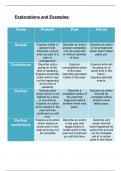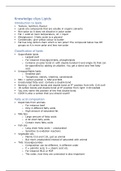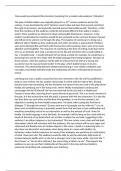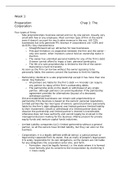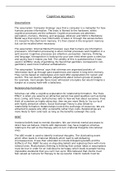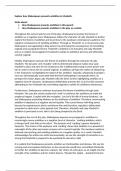Question 1
Aim of the experiment
The aim of this experiment is to see if the patient has developed enough T-cell immunity
to protect against the sars-cov-2 peptides.
Question 2
Results
Table 1 shows the vitality of cells in target cells, high effective peptide and low effective peptide,
which is the inverse of the activity of T-cell lymphocytes. This is measured with a spectrophotometer
at 490 nm.
Blanc Target cells only High effective peptide Low effective peptide
A 0,080 0,822 0,080 0,913
B 0,060 0,756 0,081 0,744
C 0,070 0,387 0,081 0,420
D 0,061 0,444 0,063 0,505
Average 0,068 0,602 0,076 0,646
Blanc corrected 0,000 0,535 0,008 0,578
0.250
0.200
absorption (490 nm)
0.150
0.100
0.050
0.000
Target cells only High effective Low effective
peptide peptide
Figure 1: shows the absorption, measured at 490 nm with a spectrophotometer, of the different
situations.
First for all repeats (A-D) per blanc, target cells only and the high- and low effective
peptide the average was calculated. After this, the average value of the blanc was
subtracted from the averages to account for background absorbance.
In column 2 only targets cells were used, resulting in an corrected averaged absorption of
0,535. In column 4, the highest absorbance could be seen. In this column a low effective
peptide was used resulting in a corrected averaged absorption of 0,578 of the wells.
However, in the in column 3 (which exists of high effective peptide) it is obtained that the
absorption is much lower compared to column 2 and 4. The corrected averaged
absorption of column 3 is 0,008.
In figure 1, can be seen that the first and last column have quite a high standard deviation.
In comparison with the high effective peptide, the standard deviation is very low compared
to the other two environments.
Aim of the experiment
The aim of this experiment is to see if the patient has developed enough T-cell immunity
to protect against the sars-cov-2 peptides.
Question 2
Results
Table 1 shows the vitality of cells in target cells, high effective peptide and low effective peptide,
which is the inverse of the activity of T-cell lymphocytes. This is measured with a spectrophotometer
at 490 nm.
Blanc Target cells only High effective peptide Low effective peptide
A 0,080 0,822 0,080 0,913
B 0,060 0,756 0,081 0,744
C 0,070 0,387 0,081 0,420
D 0,061 0,444 0,063 0,505
Average 0,068 0,602 0,076 0,646
Blanc corrected 0,000 0,535 0,008 0,578
0.250
0.200
absorption (490 nm)
0.150
0.100
0.050
0.000
Target cells only High effective Low effective
peptide peptide
Figure 1: shows the absorption, measured at 490 nm with a spectrophotometer, of the different
situations.
First for all repeats (A-D) per blanc, target cells only and the high- and low effective
peptide the average was calculated. After this, the average value of the blanc was
subtracted from the averages to account for background absorbance.
In column 2 only targets cells were used, resulting in an corrected averaged absorption of
0,535. In column 4, the highest absorbance could be seen. In this column a low effective
peptide was used resulting in a corrected averaged absorption of 0,578 of the wells.
However, in the in column 3 (which exists of high effective peptide) it is obtained that the
absorption is much lower compared to column 2 and 4. The corrected averaged
absorption of column 3 is 0,008.
In figure 1, can be seen that the first and last column have quite a high standard deviation.
In comparison with the high effective peptide, the standard deviation is very low compared
to the other two environments.


